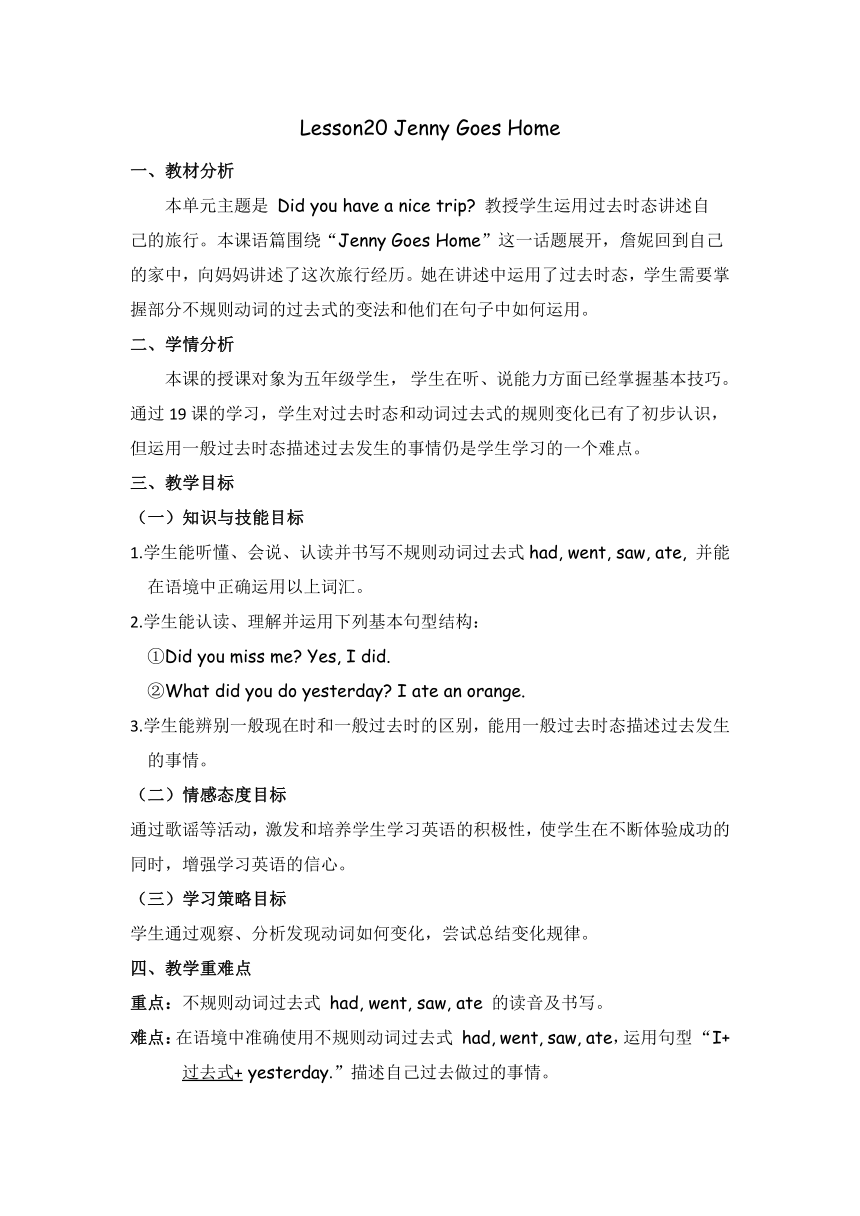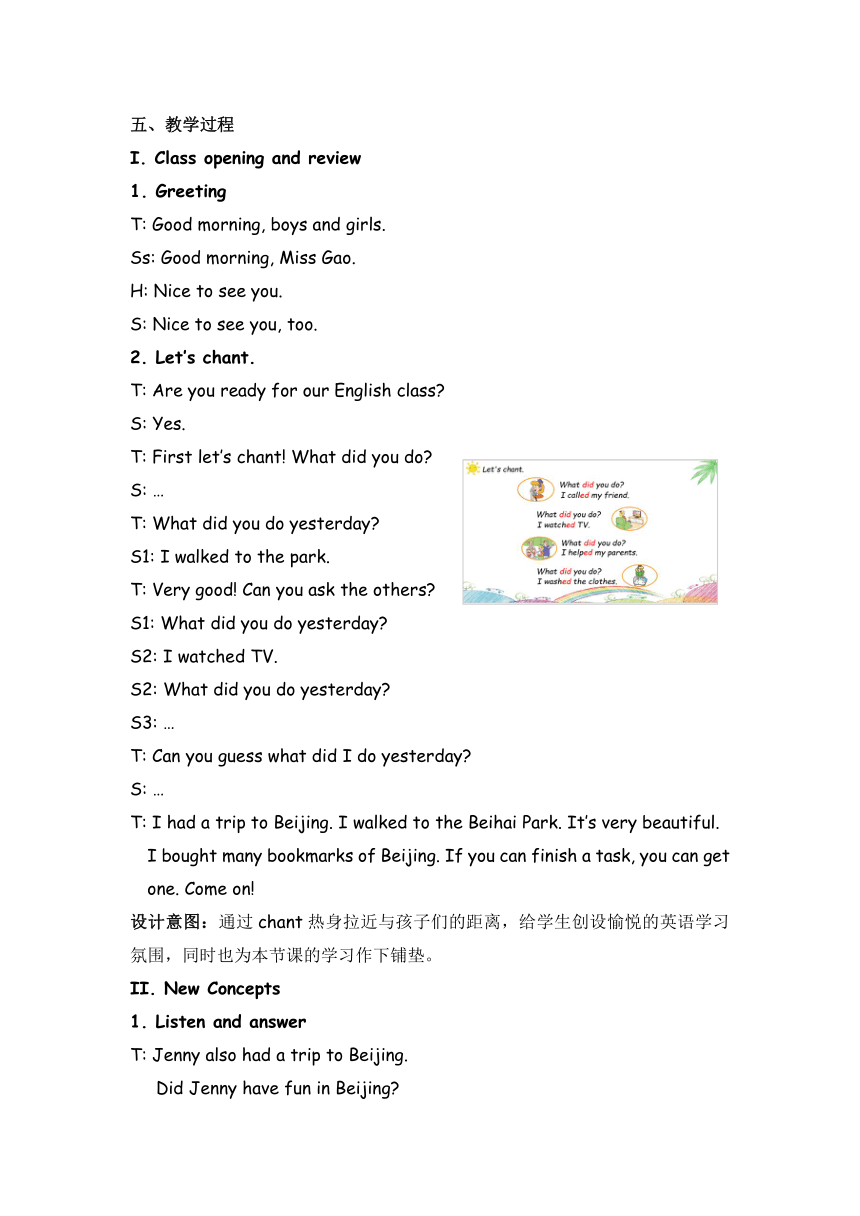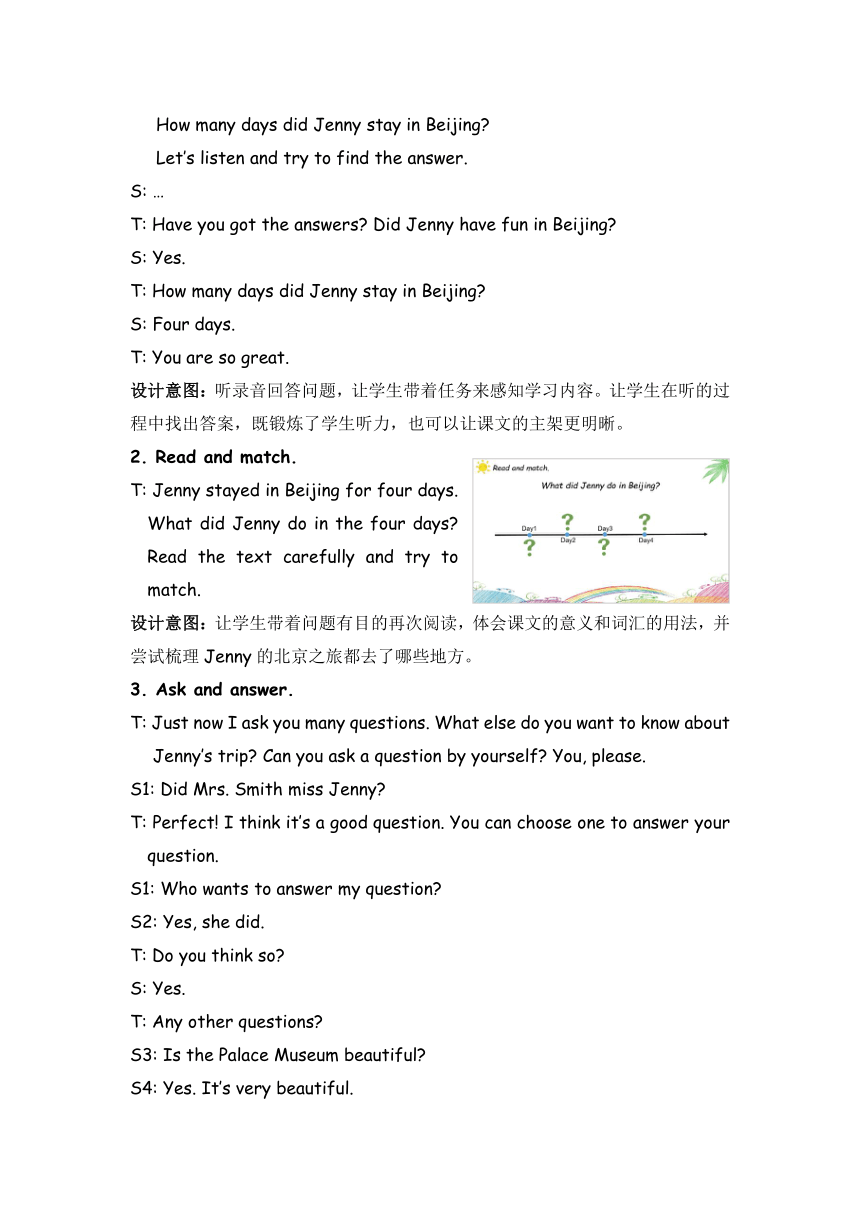Unit 4 Lesson 20 Jenny Goes Home 教案
文档属性
| 名称 | Unit 4 Lesson 20 Jenny Goes Home 教案 |  | |
| 格式 | doc | ||
| 文件大小 | 1.2MB | ||
| 资源类型 | 教案 | ||
| 版本资源 | 冀教版(三年级起点) | ||
| 科目 | 英语 | ||
| 更新时间 | 2021-06-13 10:43:56 | ||
图片预览



文档简介
Lesson20 Jenny Goes Home
一、教材分析
本单元主题是 Did you have a nice trip? 教授学生运用过去时态讲述自 己的旅行。本课语篇围绕“Jenny?Goes?Home”这一话题展开,詹妮回到自己的家中,向妈妈讲述了这次旅行经历。她在讲述中运用了过去时态,学生需要掌握部分不规则动词的过去式的变法和他们在句子中如何运用。
二、学情分析
本课的授课对象为五年级学生,?学生在听、说能力方面已经掌握基本技巧。通过19课的学习,学生对过去时态和动词过去式的规则变化已有了初步认识,但运用一般过去时态描述过去发生的事情仍是学生学习的一个难点。
三、教学目标
(一)知识与技能目标
1.学生能听懂、会说、认读并书写不规则动词过去式had, went, saw, ate, 并能
在语境中正确运用以上词汇。
2.学生能认读、理解并运用下列基本句型结构:
①Did you miss me? Yes, I did.
②What did you do yesterday? I ate an orange.
3.学生能辨别一般现在时和一般过去时的区别,能用一般过去时态描述过去发生的事情。
(二)情感态度目标
通过歌谣等活动,激发和培养学生学习英语的积极性,使学生在不断体验成功的同时,增强学习英语的信心。
(三)学习策略目标
学生通过观察、分析发现动词如何变化,尝试总结变化规律。
四、教学重难点
重点:不规则动词过去式 had, went, saw, ate 的读音及书写。
难点:在语境中准确使用不规则动词过去式 had, went, saw, ate,运用句型 “I+过去式+ yesterday.”描述自己过去做过的事情。?
五、教学过程
I. Class opening and review
1. Greeting
T: Good morning, boys and girls.
Ss: Good morning, Miss Gao.
H: Nice to see you.
S: Nice to see you, too.
2. Let’s chant.
T: Are you ready for our English class?
S: Yes.
T: First let’s chant! What did you do?
S:
T: What did you do yesterday?
S1: I walked to the park.
T: Very good! Can you ask the others?
S1: What did you do yesterday?
S2: I watched TV.
S2: What did you do yesterday?
S3:
T: Can you guess what did I do yesterday?
S:
T: I had a trip to Beijing. I walked to the Beihai Park. It抯 very beautiful.
I bought many bookmarks of Beijing. If you can finish a task, you can get one. Come on!
设计意图:通过chant热身拉近与孩子们的距离,给学生创设愉悦的英语学习氛围,同时也为本节课的学习作下铺垫。
II. New Concepts
1. Listen and answer
T: Jenny also had a trip to Beijing.
Did Jenny have fun in Beijing?
How many days did Jenny stay in Beijing?
Let’s listen and try to find the answer.
S: …
T: Have you got the answers? Did Jenny have fun in Beijing?
S: Yes.
T: How many days did Jenny stay in Beijing?
S: Four days.
T: You are so great.
设计意图:听录音回答问题,让学生带着任务来感知学习内容。让学生在听的过程中找出答案,既锻炼了学生听力,也可以让课文的主架更明晰。
2. Read and match.
T: Jenny stayed in Beijing for four days. What did Jenny do in the four days? Read the text carefully and try to match.
设计意图:让学生带着问题有目的再次阅读,体会课文的意义和词汇的用法,并尝试梳理Jenny的北京之旅都去了哪些地方。
3. Ask and answer.
T: Just now I ask you many questions. What else do you want to know about
Jenny抯 trip? Can you ask a question by yourself? You, please.
S1: Did Mrs. Smith miss Jenny?
T: Perfect! I think it抯 a good question. You can choose one to answer your question.
S1: Who wants to answer my question?
S2: Yes, she did.
T: Do you think so?
S: Yes.
T: Any other questions?
S3: Is the Palace Museum beautiful?
S4: Yes. It抯 very beautiful.
S5: Did Jenny go shopping in Beijing?
S6: Yes, she did.
S7: What did Jenny buy for her mother?
S8: A scarf.
设计意图:在初步理解课文大意的基础上,由学生就”Jenny’s Trip” 自主提问,将课堂的主动权交给学生,让学生真正成为课堂的主人。在生生互问互答的过程中教师适时补充完善板书,帮助学生深入理解课文。
4. Listen and imitate.
T: Jenny had a good trip in Beijing. Now let’s listen and imitate. Please?pay attention to?your?pronunciation and?intonation.
S: …
5. Read in roles.
T: Now you can read the text in roles.
Then I will choose some of you to show.
S: …
T: Okay, Boys and girls. Who wants to show?
S: …
T: Good job. A bookmark for you.
S: Thank you.
T: You are welcome.
设计意图:表扬学生的精彩表现,让他们在成功中体验学习的乐趣,培养持久的学习兴趣。
6. Look and find.
T: Jenny had a nice trip in Beijing. But she went home now. How’s Jenny’s
life in Canada? Let’s have a look! (出示PPT)
S:…
T: What did Jenny do yesterday?(板书)
S:…
T: Look at the sentences carefully. What differences can you find?
Pay attention to the red words.
S:…
T: You can speak in Chinese.
S: 左边都是过去时,右边都是一般现在时。
T:How do you know?
S:
T: When do we use the past tense?
S: Yesterday.
T: Very good. When we see “yesterday” or ”last…”, we should use the past
tense.
S: …
T: 总结不规则变化动词规律。
设计意图:让学生通过观察句子及表格自己发现并总结动词变过去式的规律,培养学生的自主探究能力。
7. Read and complete.
T: That’s Jenny’s life in Canada. How about Danny? Read and try to complete.
设计意图:创设真实的语言环境,让学生在情景中学习,提高学生的学习兴趣,同时巩固练习本课所学的动词过去式。
8. Talk and write.
T: It’s Danny’s day. How about your day? Talk in pairs, please.
S: …
T: Try to write down, please.
S: …
设计意图:引导学生根据所给情景,模仿上面的练习写话,这个环节是对教材的一个延伸,也是与学生息息相关的一个话题,通过创设情境使学生能将本节课所学的语言知识综合运用,提高自主学习的能力,培养小组合作的精神。
III. Class Closing
一、教材分析
本单元主题是 Did you have a nice trip? 教授学生运用过去时态讲述自 己的旅行。本课语篇围绕“Jenny?Goes?Home”这一话题展开,詹妮回到自己的家中,向妈妈讲述了这次旅行经历。她在讲述中运用了过去时态,学生需要掌握部分不规则动词的过去式的变法和他们在句子中如何运用。
二、学情分析
本课的授课对象为五年级学生,?学生在听、说能力方面已经掌握基本技巧。通过19课的学习,学生对过去时态和动词过去式的规则变化已有了初步认识,但运用一般过去时态描述过去发生的事情仍是学生学习的一个难点。
三、教学目标
(一)知识与技能目标
1.学生能听懂、会说、认读并书写不规则动词过去式had, went, saw, ate, 并能
在语境中正确运用以上词汇。
2.学生能认读、理解并运用下列基本句型结构:
①Did you miss me? Yes, I did.
②What did you do yesterday? I ate an orange.
3.学生能辨别一般现在时和一般过去时的区别,能用一般过去时态描述过去发生的事情。
(二)情感态度目标
通过歌谣等活动,激发和培养学生学习英语的积极性,使学生在不断体验成功的同时,增强学习英语的信心。
(三)学习策略目标
学生通过观察、分析发现动词如何变化,尝试总结变化规律。
四、教学重难点
重点:不规则动词过去式 had, went, saw, ate 的读音及书写。
难点:在语境中准确使用不规则动词过去式 had, went, saw, ate,运用句型 “I+过去式+ yesterday.”描述自己过去做过的事情。?
五、教学过程
I. Class opening and review
1. Greeting
T: Good morning, boys and girls.
Ss: Good morning, Miss Gao.
H: Nice to see you.
S: Nice to see you, too.
2. Let’s chant.
T: Are you ready for our English class?
S: Yes.
T: First let’s chant! What did you do?
S:
T: What did you do yesterday?
S1: I walked to the park.
T: Very good! Can you ask the others?
S1: What did you do yesterday?
S2: I watched TV.
S2: What did you do yesterday?
S3:
T: Can you guess what did I do yesterday?
S:
T: I had a trip to Beijing. I walked to the Beihai Park. It抯 very beautiful.
I bought many bookmarks of Beijing. If you can finish a task, you can get one. Come on!
设计意图:通过chant热身拉近与孩子们的距离,给学生创设愉悦的英语学习氛围,同时也为本节课的学习作下铺垫。
II. New Concepts
1. Listen and answer
T: Jenny also had a trip to Beijing.
Did Jenny have fun in Beijing?
How many days did Jenny stay in Beijing?
Let’s listen and try to find the answer.
S: …
T: Have you got the answers? Did Jenny have fun in Beijing?
S: Yes.
T: How many days did Jenny stay in Beijing?
S: Four days.
T: You are so great.
设计意图:听录音回答问题,让学生带着任务来感知学习内容。让学生在听的过程中找出答案,既锻炼了学生听力,也可以让课文的主架更明晰。
2. Read and match.
T: Jenny stayed in Beijing for four days. What did Jenny do in the four days? Read the text carefully and try to match.
设计意图:让学生带着问题有目的再次阅读,体会课文的意义和词汇的用法,并尝试梳理Jenny的北京之旅都去了哪些地方。
3. Ask and answer.
T: Just now I ask you many questions. What else do you want to know about
Jenny抯 trip? Can you ask a question by yourself? You, please.
S1: Did Mrs. Smith miss Jenny?
T: Perfect! I think it抯 a good question. You can choose one to answer your question.
S1: Who wants to answer my question?
S2: Yes, she did.
T: Do you think so?
S: Yes.
T: Any other questions?
S3: Is the Palace Museum beautiful?
S4: Yes. It抯 very beautiful.
S5: Did Jenny go shopping in Beijing?
S6: Yes, she did.
S7: What did Jenny buy for her mother?
S8: A scarf.
设计意图:在初步理解课文大意的基础上,由学生就”Jenny’s Trip” 自主提问,将课堂的主动权交给学生,让学生真正成为课堂的主人。在生生互问互答的过程中教师适时补充完善板书,帮助学生深入理解课文。
4. Listen and imitate.
T: Jenny had a good trip in Beijing. Now let’s listen and imitate. Please?pay attention to?your?pronunciation and?intonation.
S: …
5. Read in roles.
T: Now you can read the text in roles.
Then I will choose some of you to show.
S: …
T: Okay, Boys and girls. Who wants to show?
S: …
T: Good job. A bookmark for you.
S: Thank you.
T: You are welcome.
设计意图:表扬学生的精彩表现,让他们在成功中体验学习的乐趣,培养持久的学习兴趣。
6. Look and find.
T: Jenny had a nice trip in Beijing. But she went home now. How’s Jenny’s
life in Canada? Let’s have a look! (出示PPT)
S:…
T: What did Jenny do yesterday?(板书)
S:…
T: Look at the sentences carefully. What differences can you find?
Pay attention to the red words.
S:…
T: You can speak in Chinese.
S: 左边都是过去时,右边都是一般现在时。
T:How do you know?
S:
T: When do we use the past tense?
S: Yesterday.
T: Very good. When we see “yesterday” or ”last…”, we should use the past
tense.
S: …
T: 总结不规则变化动词规律。
设计意图:让学生通过观察句子及表格自己发现并总结动词变过去式的规律,培养学生的自主探究能力。
7. Read and complete.
T: That’s Jenny’s life in Canada. How about Danny? Read and try to complete.
设计意图:创设真实的语言环境,让学生在情景中学习,提高学生的学习兴趣,同时巩固练习本课所学的动词过去式。
8. Talk and write.
T: It’s Danny’s day. How about your day? Talk in pairs, please.
S: …
T: Try to write down, please.
S: …
设计意图:引导学生根据所给情景,模仿上面的练习写话,这个环节是对教材的一个延伸,也是与学生息息相关的一个话题,通过创设情境使学生能将本节课所学的语言知识综合运用,提高自主学习的能力,培养小组合作的精神。
III. Class Closing
同课章节目录
- Unit 1 Going to Beijing
- Lesson 1 I Am Excited!
- Lesson 2 What Are You Doing?
- Lesson 3 Who Is Singing?
- Lesson 4 Who Is Hungry?
- Lesson 5 What Are They Doing?
- Lesson 6 Danny Is Lost!
- Again, Please!
- Unit 2 In Beijing
- Lesson 7 Arriving in Beijing
- Lesson 8 Tian'anmem Square
- Lesson 9 The Palace Museum
- Lesson 10 The Great Wall
- Lesson 11 Shopping in Beijing
- Lesson 12 A Visit to the Great Wall
- Again, Please!
- Unit 3 Writing Home
- Lesson 13 Let's Buy Postcards!
- Lesson 14 Jenny Writes a Postcard
- Lesson 15 Sending the Postcards
- Lesson 16 An Email Is Fast
- Lesson 17 Danny's Email
- Lesson 18 Little Zeke Sends an Email
- Unit 4 Did You Have a Nice Trip?
- Lesson 19 Li Ming Goes Home
- Lesson 20 Jenny Goes Home
- Lesson 21 Look at the Photos!
- Lesson 22 Gifts for Everyone
- Lesson 23 An Email from Li Ming
- Lesson 24 A Gift for Little Zeke
